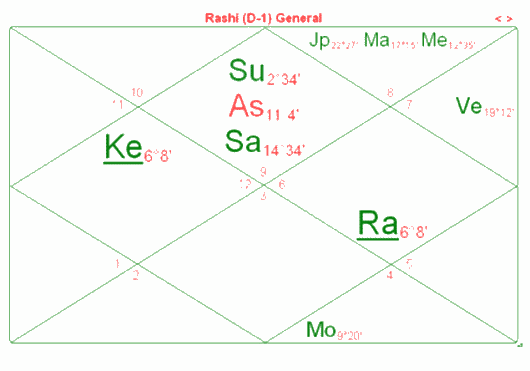Spring | Summer | Fall | Winter | |
2025 | Volume 67 |
| Volume 65 | Volume 66 |
Volume 13, 21 June 2011
“ Oh, the summer night
Has a smile of light
And she sits on a sapphire throne. ”
The Sky Above
The delight of warm summer evenings perfectly coincides with rich viewing opportunities over the next three months. It is an excellent time to locate some of the key nakshatras as various planets will be very close to the marker stars of these lunar constellations.
Here are some of the events that will be visible without binoculars:
Jupiter-Moon
On both June 26th and July 23rd, you can see a shining Jupiter close to the Moon around an hour before sunrise in the East. On the earlier date, it will be a bit below the waning crescent Moon. Both Jupiter and the Moon will be right with the marker stars for the constellation of Aswini. All the stars of Aries are very faint so it may be hard to see. On the July date, Jupiter will be a bit further away and to the lower left of the third quarter Moon. Again they will be hovering around Aswini though Jupiter will have moved out of the “official” boundary between Aswini and Bharani.
If you don’t like to get up early, you get your chance to see Jupiter and the Moon on the Eastern horizon August 19th around three hours after sunset and on September 16th around two hours after sunset. Neither will be right with the marker star for Bharani though on the later date, the Moon will be around three degrees away. You might see the very faint triangle that makes up Bharani. On the 19th, the waning Moon will be right above Jupiter and on the 16th, it will be further away and to the left.
Mars - Aldeberan
Red meets red when Mars sits just to the upper left of the red giant star Aldeberan. Aldeberan is the Arabic name but in the Indian tradition, this is the beautiful marker star of Rohini nakshatra - the favorite wife of the Moon. This viewing takes place on July 5th around an hour before sunrise near the East/Northeast horizon. Rohini will actually be brighter than Mars.
The Elusive Mercury
September 3rd is an opportunity to see Mercury even without binoculars. It is at its greatest elongation (distance) west of the Sun. You can see it low in the eastern sky around an hour before sunrise. It will be an interesting viewing as there are several other bright stars and the planet Mars all visible in the same area. Your eye will immediately be drawn to Sirius which is probably the brightest star around and is the marker star of Canis Major - the larger dog - said to be following the hunter Orion. Mercury is, however, a distance to the left of Sirius and below the principal star of Canis Minor – the little dog. Above Mercury is Castor and Pollux which are the marker stars of the nakshatra Punarvasu. Mars is very close to those two bright stars.
The Fullness of Guru
Honoring the teacher finds its pinnacle in the beautiful festival of Guru Purnima celebrated in both Hindu and Buddhist traditions. The meaning of this expression is literally “the fullness of the guru”.
The two syllables of the word guru reveal how a teacher is viewed in these cultures.
There are many levels of gurus. The one who reveals the highest knowledge and leads us from darkness into light, from limitation to eternal freedom is the true or sat guru. Yet the value of knowledge is so intrinsic to the Indian heart and mind, even those involved in more mundane teachings are called gurus and are highly respected. I remember seeing hordes of school children from very poor areas immaculately dressed as they were sent off to school. That was the way their families respected even the primary education that their children were given.
Guru Purnima takes place on the full moon day (purnima) in the month of Ashadha and usually falls in July. For Buddhists, it is said to be when Lord Buddha gave his first sermon. It is also said to be the day that Vyasa was born. It is therefore known as Vyasa Purnima as well as Guru Purnima. Vyasa was the highly revered author of the Mahabharata and the great sage who compiled the Vedas into four parts. With the help of Ganapati, he wrote them down as he foresaw that the memory of man would fail in subsequent time periods or yugas.
For all the Hindu traditions, it is the reaffirmation of the Sampradaya – the great Guru Shisya Parampara - teacher/student oral tradition - which has protected this knowledge through the millennia and allowed it to be passed down in its purity.
It is a day and evening of beautiful observances and rituals. It is said that seva done for the guru on this day produces bounteous grace as the spiritual presence of the guru is very powerful.
Gurur Brahma Gurur Vishnu Gurur Devo Mahesvaraha
Guru Saakshaat Para Brahma Tasmai Shri Gurave Namaha
My salutations to the Guru in the form of Lord Brahma, Vishnu and Mahesvara (Siva)
Guru is the most exalted expression of knowledge - Brahma incarnate
The Purushartha of Moksha
All living creatures are expressions of spirit and therefore reflect its unbounded eternal nature. That essential essence translates in our lives as human beings as the desire to be free. It winds up being expressed in infinitely diverse ways but the fact is that no one wants restrictions and bondage in their lives. This principle of ultimate freedom is moksha.
We are perhaps most familiar with the term moksha in its highest expression as expounded by the great teachers unveiling the wisdom of the Upanishads. In that context, it is revealed as the ultimate state of unity, the cognitive shift that releases a seeker from the identification with the material level of existence which is the cause of suffering and duality.
However, we all experience moksha on a daily basis when we sleep. We are released from the stress and strain of our everyday life and we are free. We also experience it when we clean out our closets and “let go” of things. So we can think of moksha in terms of letting go, of being less attached and less identified with the outer world. It is also applicable to all transformational processes.
In Jyotisha, the purushartha of moksha is analyzed by looking at the 4th, 8th and 12th bhavas and their lords. We are also interested in Ketu which in this context is known as the moksha karaka or significator. Jupiter is another contributor in the sense of promoting dharma which makes one more fit for the dawning of the unity experience. The water rashis of Cancer, Scorpio and especially Pisces are also factors.
Here is a chart that presents the ideal interaction of all these factors.

Note that all the moksha lords are in moksha bhavas i.e. the 12th lord Mars is in the 12th with the 4th lord Jupiter. The 8th lord Moon is in its own house. Furthermore, the first lord Jupiter goes to a moksha bhava (it is in the 12th) and aspects all the other moksha bhavas. The moksha karaka Ketu is in a moksha bhava (the 4th) in the rashi of Pisces and aspected by lagna lord and 4th lord Jupiter without affliction from any natural malefic.
Despite the difficulties inherent in this chart, I remember so vividly that this person told me that her earliest impulse in life from the very beginning was to pray and lose herself in the vastness that she knew was within.
The Media Corner
Crystal and Dragon:
The Cosmic Dance of Symmetry and Chaos in Nature, Art and Consciousness
by David Wade
ISBN 0-89281-404-7
We live in a universe of necessary dualities: light and darkness, reason and romance, order and chaos, which can be viewed in terms of the rigidly structured and ordered “crystal” on the one hand and the flowing and mutable “dragon” on the other.
David Wade traces this interplay of form and energy in the histories of religion, philosophy, science and art. He vividly illustrates the interconnectedness of these various traditions through enchanting drawings that portray this entwining of order and chaos, timings and processes throughout nature and art.












